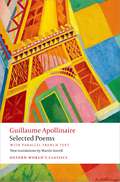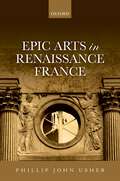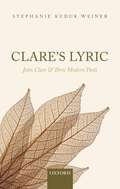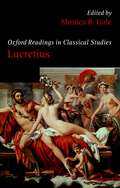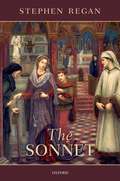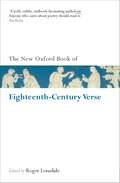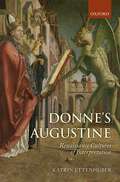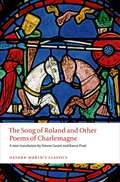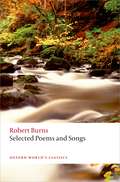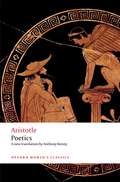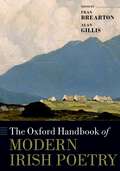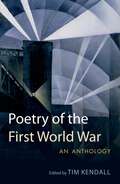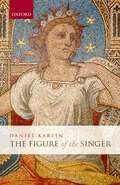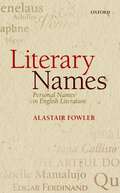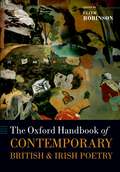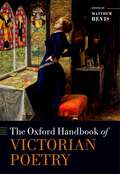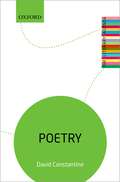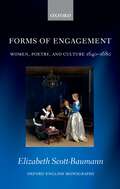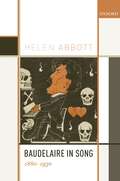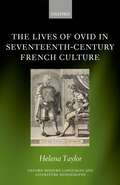- Table View
- List View
Selected Poems: with parallel French text (Oxford World's Classics)
by Guillaume Apollinaire'In the end you're tired of this antiquated world' Guillaume Apollinaire (1880-1918) is the most significant French poet of early modernism, and the most colourful. His exuberant, adventurous poetry matched the eventful times through which he lived, and his experimentalism heralded a new artistic order. In the Paris of the belle époque, Apollinaire's prolific writing - poems, short stories, erotic novels, art criticism - as well as his magnetic personality brought him fame and even some notoriety. His two great collections of poetry, Alcools and Calligrammes, made his reputation, and they include love poems as well as the war poetry for which he is best known. Apollinaire coined the word 'surrealism', and he led the literary and artistic avant-garde right up to his death two days before the Armistice, weakened by injuries received earlier in the War. This new selection by Martin Sorrell covers the full range of Apollinaire's career, and includes some of the poet's inventive pictorial calligrams. The introduction and notes explore his seminal role in the culture of the twentieth century. ABOUT THE SERIES: For over 100 years Oxford World's Classics has made available the widest range of literature from around the globe. Each affordable volume reflects Oxford's commitment to scholarship, providing the most accurate text plus a wealth of other valuable features, including expert introductions by leading authorities, helpful notes to clarify the text, up-to-date bibliographies for further study, and much more.
Epic Arts In Renaissance France
by Phillip John UsherEpic Arts in Renaissance France studies the relationship between epic literature and other art forms such as painting, sculpture, and architecture. Why, the book asks, the epic heroes and themes so ubiquitous in French Renaissance art are widely celebrated whereas the same period's literary epics, frequently maligned, now go unread? To explore this paradox, the book investigates a number of epic building sites, i.e. specific situations in which literary epics either become the basis for realisations in other art forms or somehow contest or compete with them. Beginning with a detour about the appearance of epic heroes (Odysseus and Aeneas) on marriage chests in fifteenth-century Florence, the study traces how French communities of readers, writers, translators, and artists reinvent epic forms in their own—or their patron's—image. Following extended discussion of three galleries in different regions of France, which all depicted key scenes from the classical epics of Homer, Virgil, and Lucan, the book turns to epics written in the period. Chapters of Epic Arts focus on Etienne Dolet's Fata, which praise the victories (but also failures) of François Ier in ways that make it both a continuum of Fontainebleau and a response to the celebration of French defeat in foreign paintings; on Ronsard's Franciade, whose muse was depicted on the façade of the Louvre and whose story was eventually taken up in a long series of paintings by Toussaint Dubreuil; and on Agrippa d'Aubigné's Protestant Tragiques, which allude to, and frequently function as graffiti over, Catholic works of art in Paris and Rome. Situated at the frontier of literary criticism and art history, Epic Arts in Renaissance France is a compelling call for a revaluation of French epic literature and indeed of how we read.
Clare's Lyric: John Clare And Three Modern Poets
by Stephanie Kuduk WeinerThis book considers the lyric poems written by John Clare and three twentieth-century poets—Arthur Symons, Edmund Blunden, and John Ashbery—who turned to him at pivotal moments in their own development. These writers crafted a distinctive mode of lyric, 'Clare's lyric', that emphatically grounds its truth claims in mimetic accuracy. For these writers, accurate representation involves not only words that name objects, describe scenes, and create images pointing to a shared reality but also patterns of sound, the syntactic organization of lines, and the shapes of whole poems and collections of poems. Their works masterfully investigate how poetic language and form can refer to the world, word by word, line by line, and poem by poem. Written in a lively and accessible style, Clare's Lyric sheds light on a richly diverse body of poems and on enduring questions about how literature represents reality. Weiner's attentive close readings bring the writings of Clare, Symons, Blunden, and Ashbery to life by revealing precisely how they captured a vital, arresting, and complex world in their poems. Their unique approach to lyric is traced from Clare's poems about birdsong, his sonnets, and his later poems of loss and absence to Symons's efforts to make 'amends to nature' Blunden's vivid depictions of a European and English countryside scarred by the First World War, and Ashbery's unbounded and bountiful landscapes. This inventive study refines our understanding of the aesthetic of Romanticism, the genre of lyric, and the practice of literary representation, and it makes a compelling case for the ongoing importance of poems about nature and social life.
Oxford Readings In Lucretius (Oxford Readings In Classical Studies)
by Monica R. GaleThis book gathers together some of the most important and influential scholarly articles of the last sixty to seventy years (three of which are translated into English here for the first time) on the Roman poet Lucretius. Lucretius' philosophical epic, the De Rerum Natura or On the Nature of the Universe (c.55 BC), seeks to convince its reader of the validity of the rationalist theories of the Hellenistic thinker Epicurus. The articles collected in this volume explore Lucretius' poetic and argumentative technique from a variety of perspectives, and also consider the poem in relation to its philosophical and literary milieux, and to the values and ideology of contemporary Roman society. All quotations in Latin or Greek are translated.
The Sonnet
by Stephen ReganThe Sonnet provides a comprehensive study of one of the oldest and most popular forms of poetry, widely used by Shakespeare, Milton, and Wordsworth, and still used centuries later by poets such as Seamus Heaney, Tony Harrison, and Carol Ann Duffy. This book traces the development of the sonnet from its origins in medieval Italy to its widespread acceptance in modern Britain, Ireland, and America. It shows how the sonnet emerges from the aristocratic courtly centres of Renaissance Europe and gradually becomes the chosen form of radical political poets such as Milton. The book draws on detailed critical analysis of some of the best-known sonnets written in English to explain how the sonnet functions as a poetic form, and it argues that the flexibility and versatility of the sonnet have given it a special place in literary history and tradition.
The New Oxford Book of Eighteenth-Century Verse: Reissue (Oxford Books of Prose & Verse)
No previous anthology has succeeded in illustrating so thoroughly the kinds of verse actually written in the eighteenth century. The familiar tradition is fully represented by selections from such poets as Pope, Swift, Tomson, Gray, Smart, Goldsmith, Cowper, Burns, and Blake. In addition, the anthology includes verse by many forgotten writers, both men and women, from all levels of society. Although they have never figured in conventional literary history, they wrote humorous, idiosyncratic, and graphic verse about their personal experience and the world around them, in a way that should challenge received ideas about the period's restraints and inhibitions.
Donne's Augustine: Renaissance Cultures Of Interpretation
by Katrin EttenhuberThe poet and preacher John Donne (1572-1631) was one of the most influential authors of early modern England. Donne's Augustine examines his response to an iconic figure in the history of Western religious thought: Saint Augustine of Hippo (354-430). Katrin Ettenhuber argues that Renaissance culture saw not only a revival of the classics, but was equally indebted to the intellectual and literary legacy of the Church Fathers. The study recovers an Augustinian tradition of interpretation which permeated the religious world of the period, but which has until now been largely overlooked. She presents a comprehensive re-evaluation of Donne's writings, ranging from the poems to less familiar prose works, situates him carefully in the poetic, intellectual, and political contexts which frame his works, and engages with recent developments in both literary and historical studies. Donne's Augustine is the first sustained study of Donne's reading practices, and of the theological sources which shaped his thought. It discovers a range of medieval and early modern texts which transformed the imagination of literary writers in the period but which have been neglected so far: devotional manuals, Scripture commentaries, and religious commonplace books (often in Latin). The study pays close attention to the intellectual and political conditions which informed the reception of Augustine's works, and offers detailed readings of Donne's texts which illuminate the literary aspects of his patristic heritage. Donne's Augustine makes a significant contribution to our understanding of the larger reading and writing culture of Renaissance England, and of the religious debates and controversies in the decades leading up to the Civil War.
The Song of Roland and Other Poems of Charlemagne (Oxford World's Classics)
by Simon Gaunt Karen PrattCharles the king, our emperor great, Has been a full seven years in Spain. As far as the sea he conquered this haughty land. Not a single castle remains standing in his path Charlemagne (768-814) was crowned Holy Roman Emperor in 800 and presided over a huge empire. He frequently appears in literature as a great warlord and pious crusading figure. In 778, the rearguard of Charlemagne's retreating army was ambushed and defeated at the battle of Roncevaux. This became the inspiration for songs and poems celebrating deeds of valour in the face of overwhelming odds, through the character of Charlemagne's nephew (the imaginary) Roland. The Song of Roland is the most stirring and moving epic poem of the European Middle Ages, offering a particularly heady mixture of history, legend, and poetry. Presented here in a lively and idiomatic new translation, the Song of Roland offers fascinating insights into medieval ideas about heroism, manhood, religion, race, and nationhood which were foundational for modern European culture. The Song of Roland is accompanied here by two other medieval French epics about Charlemagne, both of which show him to be a far more equivocal figure than that portrayed by the Roland: the Occitan Daurel and Beton, in which he is a corrupt and avaricious monarch; and the Journey of Charlemagne to Jerusalem and Constantinople, which gives the heroes of the Roland a comic makeover.
Selected Poems and Songs (Oxford World's Classics Ser.)
by Robert Burns'The Poetic Genius of my Country...bade me sing the loves, the joys, the rural scenes and rural pleasures of my natal Soil, in my native tongue.' Many of the poems and songs of Robert Burns (1759-96) are familiar to readers the world over: lyrical, acerbic, comic, bawdy, democratic. They include 'To a Mouse', 'John Anderson my Jo', 'A red red Rose', 'Auld lang syne', 'Tam o 'Shanter' and many more, whose vernacular energy and simple beauty have ensured lasting popularity. This generous new selection offers Burns's work as it was first encountered by contemporary readers, presenting the texts in the contexts in which they were originally published. It reproduces the whole of Poems, chiefly in the Scottish Dialect published at Kilmarnock in 1786, the volume which made Burns famous; and it reunites a generous selection of songs from The Scots Musical Museum and A Select Collection of Scottish Airs with their full scores. Comprehensive notes describe the circumstances in which other poems and songs found their way into print, both before and after the poet's death. The edition also includes some important letters, and a full glossary to explain Scots words.
Poetics (Oxford World's Classics)
by Aristotle'What is poetry, how many kinds of it are there, and what are their specific effects?' Aristotle's Poetics is the most influential book on poetry ever written. A founding text of European aesthetics and literary criticism, from it stems much of our modern understanding of the creation and impact of imaginative writing, including poetry, drama, and fiction. For Aristotle, the art of representation conveys universal truths which we can appreciate more easily than the lessons of history or philosophy. In his short treatise Aristotle discusses the origins of poetry and its early development, the nature of tragedy and plot, and offers practical advice to playwrights. This new translation by Anthony Kenny is accompanied by associated material from Plato and a range of responses from more modern literary practitioners: Sir Philip Sidney, P. B. Shelley, and Dorothy L. Sayers. The book includes a wide-ranging introduction and notes, making this the most accessible and attractive modern edition. ABOUT THE SERIES: For over 100 years Oxford World's Classics has made available the widest range of literature from around the globe. Each affordable volume reflects Oxford's commitment to scholarship, providing the most accurate text plus a wealth of other valuable features, including expert introductions by leading authorities, helpful notes to clarify the text, up-to-date bibliographies for further study, and much more.
The Oxford Handbook of Modern Irish Poetry (Oxford Handbooks)
Forty chapters, written by leading scholars across the world, describe the latest thinking on modern Irish poetry. The Handbook begins with a consideration of Yeats's early work, and the legacy of the 19th century. The broadly chronological areas which follow, covering the period from the 1910s through to the 21st century, allow scope for coverage of key poetic voices in Ireland in their historical and political context. From the experimentalism of Beckett, MacGreevy, and others of the modernist generation, to the refashioning of Yeats's Ireland on the part of poets such as MacNeice, Kavanagh, and Clarke mid-century, through to the controversially titled post-1969 'Northern Renaissance' of poetry, this volume will provide extensive coverage of the key movements of the modern period. The Handbook covers the work of, among others, Paul Durcan, Thomas Kinsella, Brendan Kennelly, Seamus Heaney, Paul Muldoon, Michael Longley, Medbh McGuckian, and Ciaran Carson. The thematic sections interspersed throughout - chapters on women's poetry, religion, translation, painting, music, stylistics - allow for comparative studies of poets north and south across the century. Central to the guiding spirit of this project is the Handbook's consideration of poetic forms, and a number of essays explore the generic diversity of poetry in Ireland, its various manipulations, reinventions and sometimes repudiations of traditional forms. The last essays in the book examine the work of a 'new' generation of poets from Ireland, concentrating on work published in the last two decades by Justin Quinn, Leontia Flynn, Sinead Morrissey, David Wheatley, Vona Groarke, and others.
Poetry of the First World War: An Anthology (Oxford World's Classics)
The First World War produced an extraordinary flowering of poetic talent, poets whose words commemorate the conflict more personally and as enduringly as monuments in stone. Lines such as 'What passing-bells for these who die as cattle?' and 'They shall grow not old, as we that are left grow old' have come to express the feelings of a nation about the horrors and aftermath of war. This new anthology provides a definitive record of the achievements of the Great War poets. As well as offering generous selections from the celebrated soldier-poets, including Wilfred Owen, Siegfried Sassoon, Rupert Brooke, and Ivor Gurney, it also incorporates less well-known writing by civilian and women poets. Music hall and trench songs provide a further lyrical perspective on the War. A general introduction charts the history of the war poets' reception and challenges prevailing myths about the war poets' progress from idealism to bitterness. The work of each poet is prefaced with a biographical account that sets the poems in their historical context. Although the War has now passed out of living memory, its haunting of our language and culture has not been exorcised. Its poetry survives because it continues to speak to and about us.
Literary Names: Personal Names in English Literature
by Alastair FowlerWhy do authors use pseudonyms and pen-names, or ingeniously hide names in their work with acrostics and anagrams? How has the range of permissible given names changed and how is this reflected in literature? Why do some characters remain mysteriously nameless? In this rich and learned book, Alastair Fowler explores the use of names in literature of all periods - primarily English but also Latin, Greek, French, and Italian - casting an unusual and rewarding light on the work of literature itself. He traces the history of names through Homer, Spenser, Shakespeare, Milton, Thackeray, Dickens, Joyce, and Nabokov, showing how names often turn out to be the thematic focus. Fowler shows that the associations of names, at first limited, become increasingly salient and sophisticated as literature itself develops.
Literary Names: Personal Names in English Literature
by Alastair FowlerWhy do authors use pseudonyms and pen-names, or ingeniously hide names in their work with acrostics and anagrams? How has the range of permissible given names changed and how is this reflected in literature? Why do some characters remain mysteriously nameless? In this rich and learned book, Alastair Fowler explores the use of names in literature of all periods - primarily English but also Latin, Greek, French, and Italian - casting an unusual and rewarding light on the work of literature itself. He traces the history of names through Homer, Spenser, Shakespeare, Milton, Thackeray, Dickens, Joyce, and Nabokov, showing how names often turn out to be the thematic focus. Fowler shows that the associations of names, at first limited, become increasingly salient and sophisticated as literature itself develops.
The Oxford Handbook of Contemporary British and Irish Poetry (Oxford Handbooks)
The Oxford Handbook of Contemporary British and Irish Poetry offers thirty-eight chapters of ground breaking research that form a collaborative guide to the many groupings and movements, the locations and styles, as well as concerns (aesthetic, political, cultural and ethical) that have helped shape contemporary poetry in Britain and Ireland. The book's introduction offers an anthropological participant-observer approach to its variously conflicted subjects, while exploring the limits and openness of the contemporary as a shifting and never wholly knowable category. The five ensuing sections explore: a history of the period's poetic movements; its engagement with form, technique, and the other arts; its association with particular locations and places; its connection with, and difference from, poetry in other parts of the world; and its circling around such ethical issues as whether poetry can perform actions in the world, can atone, redress, or repair, and how its significance is inseparable from acts of evaluation in both poets and readers. Though the book is not structured to feature chapters on authors thought to be canonical, on the principle that contemporary writers are by definition not yet canonical, the volume contains commentary on many prominent poets, as well as finding space for its contributors' enthusiasms for numerous less familiar figures. It has been organized to be read from cover to cover as an ever deepening exploration of a complex field, to be read in one or more of its five thematically structured sections, or indeed to be read by picking out single chapters or discussions of poets that particularly interest its individual readers.
The Oxford Handbook of Contemporary British and Irish Poetry (Oxford Handbooks)
by Peter RobinsonThe Oxford Handbook of Contemporary British and Irish Poetry offers thirty-eight chapters of ground breaking research that form a collaborative guide to the many groupings and movements, the locations and styles, as well as concerns (aesthetic, political, cultural and ethical) that have helped shape contemporary poetry in Britain and Ireland. The book's introduction offers an anthropological participant-observer approach to its variously conflicted subjects, while exploring the limits and openness of the contemporary as a shifting and never wholly knowable category. The five ensuing sections explore: a history of the period's poetic movements; its engagement with form, technique, and the other arts; its association with particular locations and places; its connection with, and difference from, poetry in other parts of the world; and its circling around such ethical issues as whether poetry can perform actions in the world, can atone, redress, or repair, and how its significance is inseparable from acts of evaluation in both poets and readers. Though the book is not structured to feature chapters on authors thought to be canonical, on the principle that contemporary writers are by definition not yet canonical, the volume contains commentary on many prominent poets, as well as finding space for its contributors' enthusiasms for numerous less familiar figures. It has been organized to be read from cover to cover as an ever deepening exploration of a complex field, to be read in one or more of its five thematically structured sections, or indeed to be read by picking out single chapters or discussions of poets that particularly interest its individual readers.
The Oxford Handbook of Victorian Poetry (Oxford Handbooks)
'I am inclined to think that we want new forms . . . as well as thoughts', confessed Elizabeth Barrett to Robert Browning in 1845. The Oxford Handbook of Victorian Poetry provides a closely-read appreciation of the vibrancy and variety of Victorian poetic forms, and attends to poems as both shaped and shaping forces. The volume is divided into four main sections. The first section on 'Form' looks at a few central innovations and engagements—'Rhythm', 'Beat', 'Address', 'Rhyme', 'Diction', 'Syntax', and 'Story'. The second section, 'Literary Landscapes', examines the traditions and writers (from classical times to the present day) that influence and take their bearings from Victorian poets. The third section provides 'Readings' of twenty-three poets by concentrating on particular poems or collections of poems, offering focused, nuanced engagements with the pleasures and challenges offered by particular styles of thinking and writing. The final section, 'The Place of Poetry', conceives and explores 'place' in a range of ways in order to situate Victorian poetry within broader contexts and discussions: the places in which poems were encountered; the poetic representation and embodiment of various sites and spaces; the location of the 'Victorian' alongside other territories and nationalities; and debates about the place - and displacement - of poetry in Victorian society. This Handbook is designed to be not only an essential resource for those interested in Victorian poetry and poetics, but also a landmark publication—provocative, seminal volume that will offer a lasting contribution to future studies in the area.
Victorian Poetry (Oxford Handbooks Ser.)
by Matthew Bevis Sir James Dingemans'I am inclined to think that we want new forms . . . as well as thoughts', confessed Elizabeth Barrett to Robert Browning in 1845. The Oxford Handbook of Victorian Poetry provides a closely-read appreciation of the vibrancy and variety of Victorian poetic forms, and attends to poems as both shaped and shaping forces. The volume is divided into four main sections. The first section on 'Form' looks at a few central innovations and engagements—'Rhythm', 'Beat', 'Address', 'Rhyme', 'Diction', 'Syntax', and 'Story'. The second section, 'Literary Landscapes', examines the traditions and writers (from classical times to the present day) that influence and take their bearings from Victorian poets. The third section provides 'Readings' of twenty-three poets by concentrating on particular poems or collections of poems, offering focused, nuanced engagements with the pleasures and challenges offered by particular styles of thinking and writing. The final section, 'The Place of Poetry', conceives and explores 'place' in a range of ways in order to situate Victorian poetry within broader contexts and discussions: the places in which poems were encountered; the poetic representation and embodiment of various sites and spaces; the location of the 'Victorian' alongside other territories and nationalities; and debates about the place - and displacement - of poetry in Victorian society. This Handbook is designed to be not only an essential resource for those interested in Victorian poetry and poetics, but also a landmark publication—provocative, seminal volume that will offer a lasting contribution to future studies in the area.
Poetry: The Literary Agenda (Modern Poetry In Translation Ser. #No. 10)
by David ConstantineThe Literary Agenda is a series of short polemical monographs about the importance of literature and of reading in the wider world and about the state of literary education inside schools and universities. The category of 'the literary' has always been contentious. What is clear, however, is how increasingly it is dismissed or is unrecognised as a way of thinking or an arena for thought. It is sceptically challenged from within, for example, by the sometimes rival claims of cultural history, contextualized explanation, or media studies. It is shaken from without by even greater pressures: by economic exigency and the severe social attitudes that can follow from it; by technological change that may leave the traditional forms of serious human communication looking merely antiquated. For just these reasons this is the right time for renewal, to start reinvigorated work into the meaning and value of literary reading. In this fascinating addition to the Literary Agenda series, David Constantine argues that poetry matters. It matters for individuals and for the society they are members of. He asserts that poetry is not for the few but for the many, and belongs and can only thrive among them, speaks of and to their concerns. Poetry considers both the writing and the reading of poetry, which Constantine views as kindred activities. He examines what goes into the writing of a poem and considers what good there is in reading it. Constantine also considers translation, arguing that great benefit comes to the native language from dealings with the foreign; also, that all reading is a form of translation - of texts into the lives we lead. Altogether, Poetry is an attempt, with many quotations, to show how poetry works, what its responsibilities are, and how it may help us in our real circumstances now.
Forms Of Engagement: Women, Poetry And Culture 1640-1680 (Oxford English Monographs)
by Elizabeth Scott-BaumannWhat does it mean for a woman to write an elegy, ode, epic, or blazon in the seventeenth century? How does their reading affect women's use of particular poetic forms and what can the physical appearance of a poem, in print and manuscript, reveal about how that poem in turn was read? Forms of Engagement shows how the aesthetic qualities of early modern women's poetry emerge from the culture in which they write. It reveals previously unrecognized patterns of influence between women poets Katherine Philips, Lucy Hutchinson, and Margaret Cavendish and their peers and predecessors: how Lucy Hutchinson responded to Ben Jonson and John Milton, how Margaret Cavendish responded to Thomas Hobbes and the scientists of the early Royal Society, and how Katherine Philips re-worked Donne's lyrics and may herself have influenced Abraham Cowley and Andrew Marvell. This book places analysis of form at the centre of an historical study of women writers, arguing that reading for form is reading for influence. Hutchinson, Philips, and Cavendish were immersed in mid-seventeenth century cultural developments, from the birth of experimental philosophy, to the local and state politics of civil war and the rapid expansion of women's print publication. For women poets, reworking poetic forms such as elegy, ode, epic, and couplet was a fundamental engagement with the culture in which they wrote. By focusing on these interactions, rather than statements of exclusion and rejection, a formalist reading of these women can actually provide a more nuanced historical view of their participation in literary culture.
Baudelaire in Song: 1880-1930
by Helen AbbottWhy do we find it hard to explain what happens when words are set to music? This study looks at the kind of language we use to describe word/music relations, both in the academic literature and in manuals for singers or programme notes prepared by professional musicians. Helen Abbott's critique of word/music relations interrogates overlaps emerging from a range of academic disciplines including translation theory, adaptation theory, word/music theory, as well as critical musicology, métricométrie, and cognitive neuroscience. It also draws on other resources-whether adhesion science or financial modelling-to inform a new approach to analysing song in a model proposed here as the assemblage model. The assemblage model has two key stages of analysis. The first stage examines the bonds formed between the multiple layers that make up a song setting (including metre/prosody, form/structure, sound repetition, semantics, and live performance options). The second stage considers the overall outcome of each song in terms of the intensity or stability of the words and music present in a song (accretion/dilution). Taking the work of the major nineteenth-century French poet Charles Baudelaire (1821-67) as its main impetus, the volume examines how Baudelaire's poetry has inspired composers of all genres across the globe, from the 1860s to the present day. The case studies focus on Baudelaire song sets by European composers between 1880 and 1930, specifically Maurice Rollinat, Gustave Charpentier, Alexander Gretchaninov, Louis Vierne, and Alban Berg. Using this corpus, it tests out the assemblage model to uncover what happens to Baudelaire's poetry when it is set to music. It factors in the realities of song as a live performance genre, and reveals which parameters of song emerge as standard for French text-setting, and where composers diverge in their approach.
Baudelaire in Song: 1880-1930
by Helen AbbottWhy do we find it hard to explain what happens when words are set to music? This study looks at the kind of language we use to describe word/music relations, both in the academic literature and in manuals for singers or programme notes prepared by professional musicians. Helen Abbott's critique of word/music relations interrogates overlaps emerging from a range of academic disciplines including translation theory, adaptation theory, word/music theory, as well as critical musicology, métricométrie, and cognitive neuroscience. It also draws on other resources-whether adhesion science or financial modelling-to inform a new approach to analysing song in a model proposed here as the assemblage model. The assemblage model has two key stages of analysis. The first stage examines the bonds formed between the multiple layers that make up a song setting (including metre/prosody, form/structure, sound repetition, semantics, and live performance options). The second stage considers the overall outcome of each song in terms of the intensity or stability of the words and music present in a song (accretion/dilution). Taking the work of the major nineteenth-century French poet Charles Baudelaire (1821-67) as its main impetus, the volume examines how Baudelaire's poetry has inspired composers of all genres across the globe, from the 1860s to the present day. The case studies focus on Baudelaire song sets by European composers between 1880 and 1930, specifically Maurice Rollinat, Gustave Charpentier, Alexander Gretchaninov, Louis Vierne, and Alban Berg. Using this corpus, it tests out the assemblage model to uncover what happens to Baudelaire's poetry when it is set to music. It factors in the realities of song as a live performance genre, and reveals which parameters of song emerge as standard for French text-setting, and where composers diverge in their approach.
The Lives of Ovid in Seventeenth-Century French Culture (Oxford Modern Languages and Literature Monographs)
by Helena TaylorSeventeenth-century France saw one of the most significant 'culture wars' Europe has ever known. Culminating in the Quarrel of the Ancients and Moderns, this was a confrontational, transitional time for the reception of the classics. Helena Taylor explores responses to the life of the ancient Roman poet, Ovid, within this charged atmosphere. To date, criticism has focused on the reception of Ovid's enormously influential work in this period, but little attention has been paid to Ovid's lives and their uses. Through close analysis of a diverse corpus, which includes prefatory Lives, novels, plays, biographical dictionaries, poetry, and memoirs, this study investigates how the figure of Ovid was used to debate literary taste and modernity and to reflect on translation practice. It shows how the narrative of Ovid's life was deployed to explore the politics and poetics of exile writing; and to question the relationship between fiction and history. In so doing, this book identifies two paradoxes: although an ancient poet, Ovid became key to the formulation of aspects of self-consciously 'modern' cultural movements; and while Ovid's work might have adorned the royal palaces of Versailles, the poetry he wrote after being exiled by the Emperor Augustus made him a figure through which to question the relationship between authority and narrative. The Lives of Ovid in Seventeenth-Century French Culture not only nuances understanding of both Ovid and life-writing in this period, but also offers a fresh perspective on classical reception: its paradoxes, uses, and quarrels.
The Lives of Ovid in Seventeenth-Century French Culture (Oxford Modern Languages and Literature Monographs)
by Helena TaylorSeventeenth-century France saw one of the most significant 'culture wars' Europe has ever known. Culminating in the Quarrel of the Ancients and Moderns, this was a confrontational, transitional time for the reception of the classics. Helena Taylor explores responses to the life of the ancient Roman poet, Ovid, within this charged atmosphere. To date, criticism has focused on the reception of Ovid's enormously influential work in this period, but little attention has been paid to Ovid's lives and their uses. Through close analysis of a diverse corpus, which includes prefatory Lives, novels, plays, biographical dictionaries, poetry, and memoirs, this study investigates how the figure of Ovid was used to debate literary taste and modernity and to reflect on translation practice. It shows how the narrative of Ovid's life was deployed to explore the politics and poetics of exile writing; and to question the relationship between fiction and history. In so doing, this book identifies two paradoxes: although an ancient poet, Ovid became key to the formulation of aspects of self-consciously 'modern' cultural movements; and while Ovid's work might have adorned the royal palaces of Versailles, the poetry he wrote after being exiled by the Emperor Augustus made him a figure through which to question the relationship between authority and narrative. The Lives of Ovid in Seventeenth-Century French Culture not only nuances understanding of both Ovid and life-writing in this period, but also offers a fresh perspective on classical reception: its paradoxes, uses, and quarrels.
